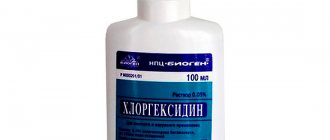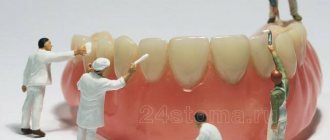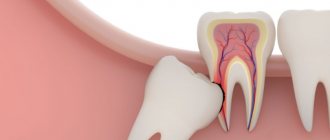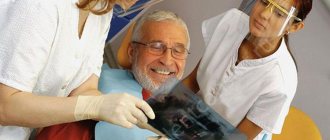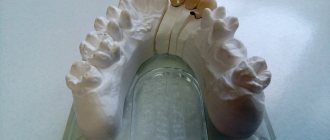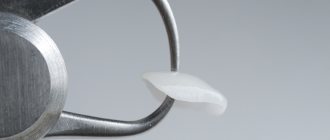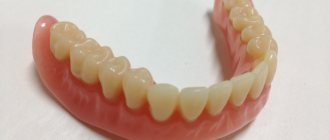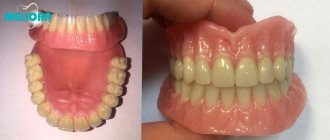People lose teeth for a variety of reasons, and such losses always need to be replaced so as not to disrupt the normal digestion process and the aesthetics of the dentition. When can prosthetics be done after tooth extraction? There is no clear answer to this question, since the clinical situation, the chosen type of prosthetics, and the condition of the tissues after the operation play a role here.
Implantation
The basis of the implant is a metal pin (titanium) that is installed in the jaw bone and replaces the tooth root. Implantation is used for the loss of one or more teeth or their complete absence. Implants made of metal-ceramic or metal-free ceramics can serve as support for a bridge structure.
The surgery is performed under anesthesia and can last 20-60 minutes. Depending on the specific situation, the implant is installed immediately after the removal of a damaged tooth or into already healed gums. The implantation scheme may vary depending on the need to build up lost bone tissue and gum formation.
The period of fusion of the metal root with bone tissue can take 3-6 months, after which the prosthesis is installed. During the implantation period, the patient can use a temporary crown.
The average service life of an implant is determined by its quality, the level of skill of the specialist, and the individual characteristics of the patient. Subject to medical recommendations - from 15 years to “for life”.
The period of adaptation to prostheses installed on implants can be several hours or 1-2 days.
Care products for implants are the same as for regular teeth:
- toothbrush with toothpaste;
- dental floss;
- rinsing or irrigation.
Twice a year it is necessary to undergo a preventive examination with a dentist. Professional cleaning is carried out as needed.
Implant installation 2-6 months after removal
Due to the longest period of clinical trials, this treatment plan is widely used among dentists. And if immediate implantation is not possible, clinicians recommend implanting an artificial root within 8-24 weeks after tooth extraction. This period is sufficient for the rehabilitation of the jaw bone and soft tissues.
Indications:
- after extraction, the diameter of the hole turned out to be larger than recommended;
- chewing molars are subject to restoration;
- additional soft tissue treatment is required, the need for which was identified after root removal.
Removable dentures
A removable denture is a base made of plastic or nylon on which artificial porcelain or plastic teeth are attached. The structure is fixed in the mouth with micro-locks, clasps, telescopic crowns or due to the suction effect. Removable dentures are used for unlimited dental defects and complete absence of teeth.
There are several types of removable dentures based on the type of fastening and base material:
- clasp;
- nylon;
- plastic with silicone gasket;
- plastic partial or complete.
Conventionally, removable clasp dentures are fixed using telescopic crowns, attachments, and clasps. They are used only in cases of partial absence of teeth. It is the most comfortable, functional and durable type of removable dentures.
A soft nylon denture is recommended in partially edentulous cases. Fits well and is easy to use.
Plastic ones with a silicone gasket are also convenient. Dentures of this type adhere more tightly and put less pressure on the gums.
Plastic full or partial are an outdated type of dentures. A budget option, which is the basis of all social programs for free prosthetics. Plastic structures are poorly fixed in the oral cavity and cannot chew solid food well.
Price
The Center for Private Dentistry Dr. Levin provides a case payment system.
- When implanting Nobel Biocare PMC Select or Groovy, the cost includes the surgical stages, including the design model, surgery, anesthesia, and all necessary procedures. The price is indicated taking into account the preparatory stage.
- Removal is paid separately, the price includes surgery, inflammation relief, socket rehabilitation, consumables, anesthesia.
- The case for installing a metal-free zirconium dioxide crown includes all stages - impressions, manufacturing, installation.
- Sinus lifting and any bone tissue augmentation operations are paid separately.
"Butterfly"
A removable microprosthesis “butterfly” comes to the rescue when 1-2 teeth are missing. The technique is used to eliminate defects in the frontal area. Its advantages:
- speed - 1-2 visits to the orthodontist;
- no need to grind adjacent teeth;
- high aesthetics;
- low price.
The “butterfly” can be made of metal ceramics, entirely of plastic on a cast frame, or with a metal wire fastening. The technique is not used to restore the dentition on the lateral areas of the jaw, which experience significant stress when chewing food.
The process of prosthetics begins with diagnosing the condition of the teeth, cleaning them from tartar, filling and removing teeth, treating gums and other measures. The period from the time of tooth extraction to the installation of a bridge, clasp or plate prosthesis is from 1 day to 1-2 months.
The technique of one-stage prosthetics is used for:
- absence of inflammatory processes and infections in the oral cavity;
- good condition of gums, teeth, bone tissue.
The general physiological condition of the patient is taken into account.
According to statistics, installation of removable dentures in place of extracted teeth is possible in 1-4 weeks.
It may take from several hours to several weeks to get used to. Not only the skill of the specialist, but also the psychological mood of the patient is of great importance. Pain may not appear immediately. Correction can be carried out no earlier than the next day, provided that the structure is in the mouth for at least 4 hours. Several adjustments may be needed.
In the first days, a speech defect is usually observed, its severity is determined by the degree of bulkiness of the structure. Patience and regular exercise will help you get rid of it in 1-3 days.
The service life of removable dentures is 5-10 years, determined by the condition of the gums and teeth (for clasp dentures).
Caring for removable dentures is similar to caring for living teeth - brushing and rinsing. Removable dentures should always be kept in a damp environment. Using a fixing cream or gel will ensure a tight fit of the structure to the gum and prevent food debris from getting under the denture. For disinfection, special antiseptic agents are used, available in the pharmacy chain.
Even if your teeth are completely missing, regular visits to the dental office are recommended to monitor the condition of the oral mucosa. If there are no problems, you should visit an orthopedic dentist at least once a year. The specialist will assess the condition of the structure and, if necessary, make corrections.
Terms of treatment and duration of procedures
How quickly the prosthesis is installed depends on the type of orthopedic structure. Thus, temporary dentures can be fixed after 20-30 minutes.
Permanent dentures are placed when the wound heals and the inflammatory process stops, i.e. about three to four weeks from the date of removal. However, prosthetics are required for a maximum of six months, otherwise bone tissue atrophy will then begin and additional sinus lift surgery will be required.
The duration of the procedure also depends on the type of prosthesis used:
- The immediate prosthesis is placed in a few minutes. However, it must be taken into account that it is also necessary to take an impression and then make the structure, which takes at least one day;
- The bridge is installed in no more than two weeks. This period includes the preparation and manufacturing stage of the structure;
- installation of a clasp prosthesis requires about 7-10 days;
- plate structures are installed within 5-10 days;
- The implantation period can range from several days to several months. Everything will depend on the chosen technique.
Fixed dentures
Fixed dentures are rigidly fixed in the oral cavity with cement compounds. They are designed to restore various defects of teeth and dentition. This:
- crowns;
- bridge structures.
Single crowns can restore the anatomical shape of a damaged tooth with preserved stability and root structure. They are made of metals, plastics, ceramics, as well as metal-plastic and metal-ceramics.
Bridge structures are bridges that completely cover the area with missing teeth. The pontic consists of artificial teeth, and the supports are made of crowns that are attached to strong teeth. When chewing food, pressure is evenly distributed throughout the dentition. Bridge structures can be solid metal or combined - metal and plastic, metal and ceramics.
Installation of fixed dentures can be carried out over several visits: grinding of the supporting teeth and making an impression, fitting of the prosthesis, correction of the structure and its fixation.
After tooth extraction, fixed dentures can be installed immediately after the wound has healed - 7-10 days. If the period of preparation for prosthetics takes a long time, the patient is made of temporary dentures for the front part of the dentition.
The less time has passed since the damage/loss of the tooth, the shorter the adaptation period.
The durability and reliability of removable dentures are determined by the general health of the patient and proper care.
Caring for removable structures consists of carrying out the usual activities: brushing your teeth with toothpaste, rinsing your mouth with special compounds. The use of dental floss is not recommended, as there is a risk of damaging the denture attachment. Regular visits to the dentist's office for diagnostic, preventive and therapeutic measures will help preserve the remaining teeth and extend the life of fixed dentures.
Indications and contraindications for immediate implant placement
Indications
- Mechanical damage to the root - fracture, dislocation
- Restoration of frontal units
- Therapeutic treatment did not bring results
- Sufficient bone volume
- No contraindications
Contraindications
- Deficiency, looseness of bone
- Inflammation at the root apex
- Enlarged socket after removal
- Inflammatory processes of the oral cavity, gum pathologies
- Reduced immunity, systemic diseases
- Pregnancy, breastfeeding period
General recommendations
During the period of adaptation to dentures, it is recommended to stop eating solid foods and choose softer foods. It is recommended to eat slowly, cutting food into small pieces. You need to chew food on the right and left sides in turn. To restore chewing skills, pear or apple slices are suitable.
It is necessary to completely avoid chewing gum, toffees, toffees and other viscous, sticky products. They can cause disruption of the fixation of the prosthesis, its breakage, and injury to the mucous membrane.
Do not clean dentures with abrasives, alcohol, alkaline or acidic solutions. The use of hard toothbrushes is not recommended. You should not chew candy, nuts, or seeds.
If you have any doubts or need a professional opinion on a problem with your prosthesis, you can contact the Canadian Center for Innovative Technology and Neuromuscular Therapy for a consultation. Our specialists will answer all your questions!
Other useful material
New implantation technologies without bone grafting
Open and closed sinus lift during implantation
Implantation of several teeth in a row
Implant installation
Temporary prosthetics
Removable appliances, bridges and other prosthetics can take a month or more to make. But it is necessary to restore a lost front tooth as quickly as possible. For these purposes, provision is made for the installation of temporary prostheses. Their wearing is indicated until the permanent structure is ready and in a number of other cases.
Temporary devices are made of plastic, since there are no strict requirements for them. Plastic products are intended for short-term use, which is justified by the low cost of the material.
